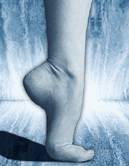- FDA Says First Round of Tests Show No Live Virus in Pasteurized Milk
- King Charles Returns to Duties After Cancer Treatment
- Biden Administration Delays Menthol Cigarette Ban
- Blood Test Might Predict Knee Osteoarthritis Years Early
- Dogs Can Get Lyme Disease, Too
- Spinal Cord Injury Damages Metabolism, and Scientists Now Know Why
- Syphilis Is Increasingly Displaying Atypical, Severe Symptoms
- Climate Change Could Be Good News for Viruses Like COVID
- Vaccines Have Saved 154 Million Lives, Mostly Babies, Over Past 50 Years
- Scientists Discover Cause of Rare Movement Disorder
Diabetes-Related Foot Condition Often Missed


A debilitating condition called Charcot foot is often missed among the nearly 30 million Americans with diabetes, doctors say.
The condition is highly treatable, but if left alone it can lead to permanent deformity, disability, surgery and even amputation, according to the American College of Foot and Ankle Surgeons (ACFAS).
Charcot foot can occur in the one-third of diabetes patients who lose feeling in their feet and other lower extremities, a condition called peripheral neuropathy.
In the early stages of Charcot foot, bones in the foot may weaken and break. Casts can help the bones heal and special orthopedic footwear can protect the feet once the bones have healed, doctors say.
But if the condition isn’t diagnosed early, the foot continues to be damaged and can become abnormal in shape. Many patients don’t know they have Charcot foot until it’s in this late stage.
“People think they don’t have a problem because they feel no pain, but that isn’t the case,” Dr. Valerie Schade, a foot and ankle surgeon in Tacoma, Wash., said in an ACFAS news release.
“Anyone at risk for neuropathy, including diabetics, alcoholics and some chemotherapy patients, should see a foot and ankle surgeon early and at least once every year, even if they are considered low-risk,” she added.
Monitoring for changes in the feet is the single most important way to prevent Charcot foot.
“Anyone who notices a difference — discomfort, unexplained swelling or redness, or changes to the shape of the foot — should seek care right away,” Schade said.
More information
The U.S. National Institute of Diabetes and Digestive and Kidney Diseases has more about diabetes and the feet.
Source: HealthDay
Copyright © 2024 HealthDay. All rights reserved.










